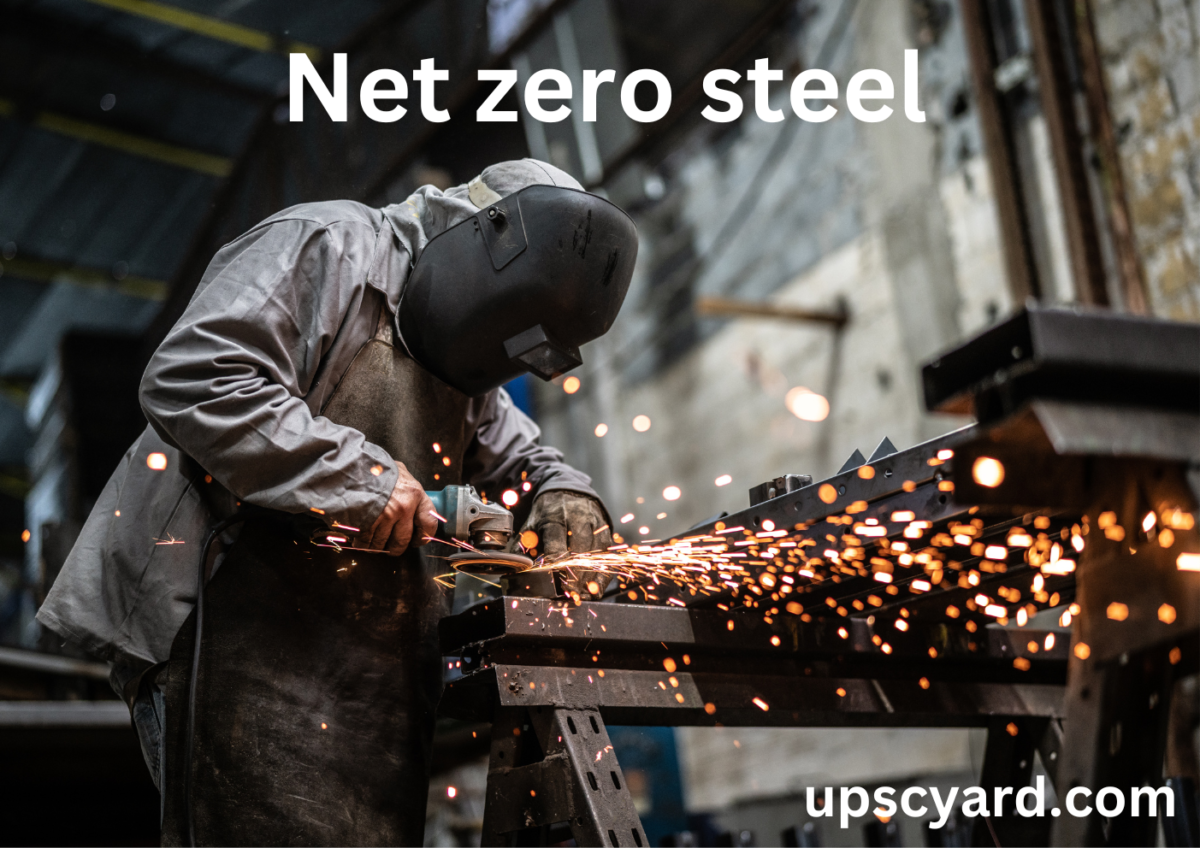Green steel | Net zero steel
Net-zero steel refers to the production of steel with minimal or zero carbon emissions throughout its lifecycle. It involves adopting sustainable practices and technologies to reduce greenhouse gas emissions associated with steel production, such as using renewable energy sources and implementing carbon capture and storage technologies.
The need for net zero steel stems from the urgent global challenge of climate change. Steel production is a significant contributor to carbon dioxide emissions, making it crucial to mitigate its environmental impact. Achieving Figures on Green steel | Net zero steel is vital to align with international climate goals and transition towards a sustainable, low-carbon economy.
In the context of the UPSC CSE examination, understanding the concept of Figures on Green steel | Net zero steel and its significance demonstrates a comprehensive understanding of sustainable development and the measures required to combat climate change. It showcases awareness of the importance of adopting environmentally friendly practices in the steel industry and the broader context of addressing global environmental challenges.
Key points
- By 2030, it is feasible to achieve a 10% reduction in carbon emissions within the steel industry without imposing significant costs on the industry or consumers.
- To achieve more substantial emission reductions, regional and international collaboration is necessary. This collaboration aims to address the green premium associated with transitioning to low-carbon practices while ensuring fair competition within the industry.
- In support of these objectives, the World Economic Forum and the Mission Possible Partnership have introduced the Figures on Green steel | Net zero steel Sector Transition Strategy. This strategy outlines actionable steps to attain these targets and highlights the transformative impact it can have on the global transition towards a net-zero economy.
Figures on Green steel | Net zero steel
An aggressive ramp-up this decade could deliver substantial emission reductions that could help the planet stay within its 1.5°C carbon budget. Incremental reductions of some 10% by 2030 could be delivered at little additional cost , The Net Zero Steel Sector Transition Strategy outlines a range of technologies that can be employed by the steel industry to achieve decarbonization.
One such technology is direct reduced iron steelmaking, which utilizes natural gas and can result in a reduction of nearly one tonne of CO2 per tonne of crude steel, equivalent to a 45% decrease compared to the average emissions intensity of primary steel production.
To achieve deeper emission reductions, carbon capture and storage (CCS) equipment can be retrofitted to existing blast furnace-basic oxygen furnaces. This implementation can lead to significant reductions in carbon emissions.
Furthermore, as the cost of producing zero-carbon hydrogen from renewable sources decreases, its utilization in steelmaking becomes increasingly cost-effective and competitive. The viability and attractiveness of these technology options are contingent upon factors such as local infrastructure availability and access to diverse energy sources.
- The steel sector is expected to have residual emissions that are difficult to eliminate entirely, amounting to approximately 300 million tonnes per year, roughly 10% of the sector’s current emissions. These residual emissions mainly stem from less-than-100% carbon capture and from electrode breakdown in electric arc furnaces. Addressing these residual emissions requires investment in carbon removal technologies or nature-based solutions.
- While the additional costs to decarbonize the steel sector by 2050 are relatively modest within the sector itself, there will be higher costs for investments in supporting infrastructure like energy generation and carbon storage, which fall outside the sector.
- Achieving a decarbonized steel sector has the potential to drive decarbonization across the economy, allowing for zero-carbon commitments in sectors such as construction, automotive, transport, energy, and packaging. Moreover, it would create demand for other crucial low-carbon transition technologies like hydrogen and carbon capture and storage (CCS), consequently contributing to cost reductions in these technologies.
Overcoming the green premium
- Overcoming the green premium is a significant obstacle for early adopters of net zero steel, as it poses a delay in the sector’s transition to low-carbon practices due to increased costs.
- The Sector Transition Strategy facilitates supply-chain collaboration and drives momentum to bridge the green premium gap for low carbon steel, enabling early action in steel decarbonization.
- Various policy measures exist to address the green premium, including public procurement commitments, government subsidies, carbon taxes, emissions trading systems, and emissions performance standards.
- Bilateral commercial agreements are emerging to create demand for low-emissions steel, such as partnerships between companies like Gestamp, ArcelorMittal, BMW, Salzgitter, and HBIS.
- Establishing a level playing field requires rigorous CO2 standards for defining “green” steel and regional agreements among steel producers, consumers, and governments to harmonize carbon pricing and regulations.
- The creation of an international forum is crucial to bring together ambitious stakeholders from the steel industry, its value chain, and governments to address obstacles in the low-carbon transition.
- Achieving net zero steel is both realistic and achievable, outlined by the Forum-supported Steel Transition Strategy, which provides a pathway for decarbonization.
- Net zero steel not only significantly reduces emissions and supports global climate goals but also stimulates the global economy with new technologies and approaches to avert a climate crisis.
INDIA’s way to Green steel | Net zero steel
The Indian steel industry is appealing for government support to facilitate the production of green steel, aligning with its goal of achieving net-zero emissions by 2070.
India has promised to be net zero on emissions by 2070. Following the target, JSW Steel aims for net-zero emissions by 2050, while Tata Steel’s target is 2045.
G20
Steel production contributes approximately 7 percent of global greenhouse gas emissions and 11 percent of global carbon dioxide emissions. Transitioning to the use of low-emission steel is crucial for decarbonizing the sector. The adoption of green procurement practices by public and private entities can serve as a catalyst in driving the demand for large-scale production of net-zero steel. Given that the G20 nations account for 90 percent of global steel production, they possess substantial influence over steel value chains.
Therefore, the G20 has a pivotal role to play in implementing mechanisms for the global decarbonization of the steel industry. This Policy Brief aims to highlight the potential of green procurement in stimulating demand for net-zero steel, outlining relevant policies and immediate actions that the G20 can implement.




